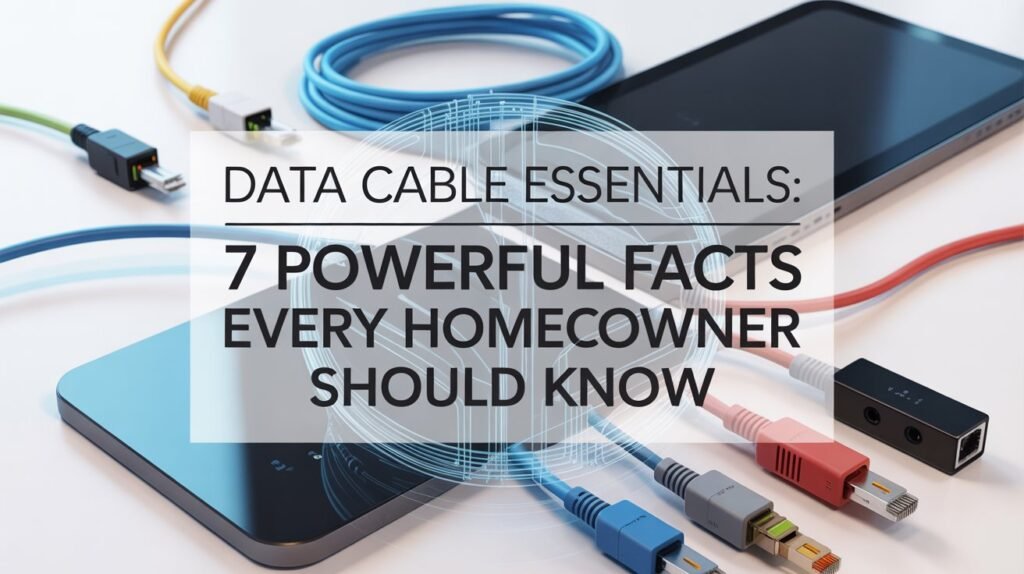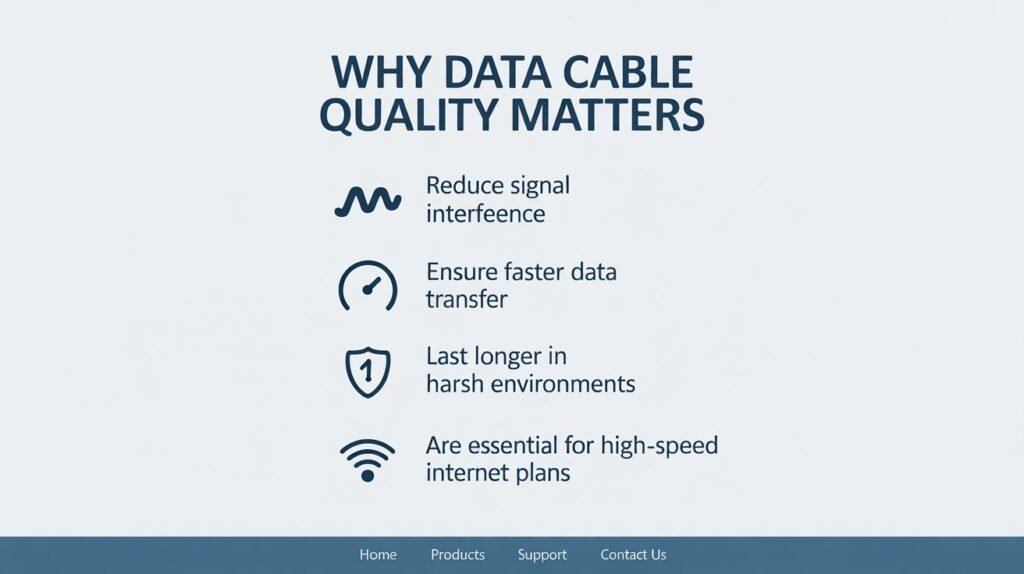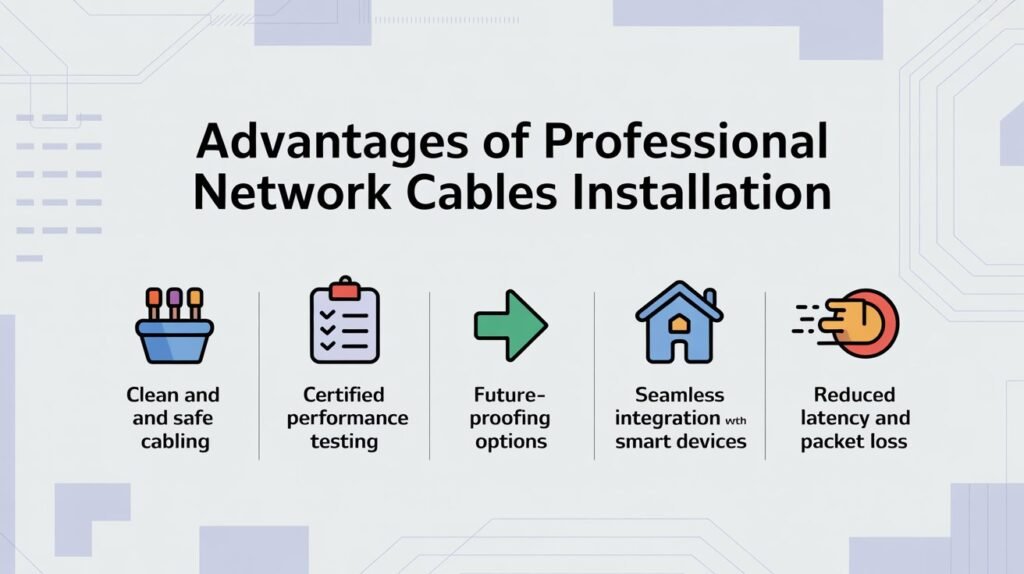In our hyper-connected world, the data cable has become the unseen backbone of our digital lives. Whether you’re streaming, gaming, working from home, or managing smart home devices, everything depends on seamless data transmission. But how much do you really know about the cables powering your internet?
This guide explores seven must-know facts about Network cables, their role in reliable internet, and why making the right choice—especially during Data Cable Installation—can transform your network experience. Whether it’s running NBN Fibre Optic Cable to your property or upgrading your Ethernet infrastructure, this article has you covered.

What Is a Data Cable?
A data cable is a medium used to transmit information electronically from one point to another. These cables are essential in creating wired connections between:
- Modems and routers
- Computers and printers
- Security systems
- Entertainment systems
From cat5e to cat8 Ethernet cables, and NBN Fibre Optic Cable, each type has its own purpose and performance capabilities. The right selection during Network cables Installation can enhance both speed and reliability in your home or business network.
Why Data Cable Quality Matters
Not all data cables are created equal. High-quality cables:
- Reduce signal interference
- Ensure faster data transfer
- Last longer in harsh environments
- Are essential for high-speed internet plans
Choosing the wrong cable during LAN cables Installation can limit your internet’s potential—especially when paired with premium services like NBN Fibre Optic Cable.

Table: Common Data Cable Types & Their Performance
| Cable Type | Max Speed | Max Distance | Ideal Use Case |
|---|---|---|---|
| Cat5e | 1 Gbps | 100m | Basic home networking |
| Cat6 | 10 Gbps (short) | 55m–100m | Office / Smart Homes |
| Cat6a | 10 Gbps | 100m | Professional setups |
| Cat7 | 10+ Gbps | 100m | High-performance networking |
| Cat8 | 40 Gbps | 30m | Data centers / Ultra HD use |
| Fibre Optic | 1–100 Gbps | Kilometers | Long-distance, high speed |
7 Must-Know Facts About Data Cables
1. The Higher the Category, the Better the Performance
Each “Cat” number indicates a performance rating. For instance, Cat6 supports up to 10 Gbps speeds—perfect for modern streaming and gaming needs.
2. Shielding Reduces Interference
Shielded Ethernet cables prevent signal loss in environments with high electrical interference, such as factories or server rooms.
3. Fibre Optics Transmit Data as Light
Unlike copper cables, NBN Fibre Optic Cable uses light signals, allowing for ultra-fast, long-distance transmission with minimal signal degradation.
4. Installation Quality Is as Important as Cable Quality
Even the best cable can underperform if installed incorrectly. Always hire experts for Data Cable Installation to ensure optimal routing, termination, and testing.
5. Outdoor and Indoor Cables Differ
Outdoor-rated cables have UV and weather resistance. Using indoor cables outdoors can cause failures and data loss.
6. Patch Cords vs. Backbone Cables
Patch cords are used for short connections (like between modem and router), while backbone cables support large-scale, long-distance data transfer.
7. Structured Cabling Future-Proofs Your Property
Installing a structured cabling system during construction or renovation adds value and ensures you’re ready for future tech upgrades—especially with the rollout of NBN Fibre Optic Cable across Australia.
How to Choose the Right Data-Cable
Factors to Consider
- Internet Speed Plan – A fast plan deserves a cable that can handle the speed.
- Distance – Longer distances may require Cat6a or fibre optics.
- Environment – Shielded cables are better for electrically noisy areas.
Installation Tips for Maximum Performance
Numbered Checklist for Smooth Setup
- Assess Your Internet Usage
- Choose the Right Cable Type
- Plan Cable Routing and Termination Points
- Use Certified Installers
- Test the Network Post-Installation
Bonus Tip:
When installing NBN Fibre Optic Cable, ensure the termination point is located centrally for even Wi-Fi distribution throughout the property.
Advantages of Professional Network cables Installation
- Clean and safe cabling
- Certified performance testing
- Future-proofing options
- Seamless integration with smart devices
- Reduced latency and packet loss

Real-World Experience
Case Example: A Perth-based small business upgraded their aging Cat5e network with Cat6a and NBN Fibre Optic Cable. The result? Internet speed increased by 85%, and VoIP call drops were eliminated entirely.
Testimonials
“We had constant dropouts until Value Services upgraded our cabling. The difference was immediate!”
— Tina L., Fremantle
“After professional Data Cable Installation, our smart home setup finally works without lag.”
— Daniel M., Joondalup
“Value Services ran fibre from the curb to our server room. Worth every cent.”
— Karen R., Perth CBD
FAQ: People Also Ask
What is a data cable used for?
A Network cables is used to transmit digital information between devices like computers, routers, and printers.
Is Cat6 better than Cat5e?
Yes, Cat6 supports higher speeds and is more resistant to interference compared to Cat5e.
Can I install data cables myself?
DIY installation is possible, but professional Ethernet cables Installation ensures optimal routing, testing, and performance.
How long do data cables last?
Quality data cables can last over 10 years if properly installed and maintained.
What’s the difference between Ethernet and fibre optic cables?
Ethernet cables use copper wires; fibre optics use light. Fibre offers faster speeds over longer distances—ideal for NBN Fibre Optic Cable setups.
Related Insights (People Also Search For)
- Ethernet cable types comparison
- Best cable for smart home setup
- How to install Cat6 cable
- NBN Fibre Optic Cable vs coaxial
- Professional LAN cables Installation near me
- Difference between shielded and unshielded data cables
Conclusion
Whether you’re upgrading your home office, installing smart home systems, or ensuring the best performance for your NBN Fibre Optic Cable connection, understanding and choosing the right data cable is essential. With proper planning and professional Data Cable Installation, you can create a robust and future-proof digital infrastructure.
Ready to upgrade your network? Don’t wait—secure high-speed connectivity with expert solutions from Value Services’ Data Cabling Professionals. From consultation to installation, we ensure your network performs at its best—now and into the future.

